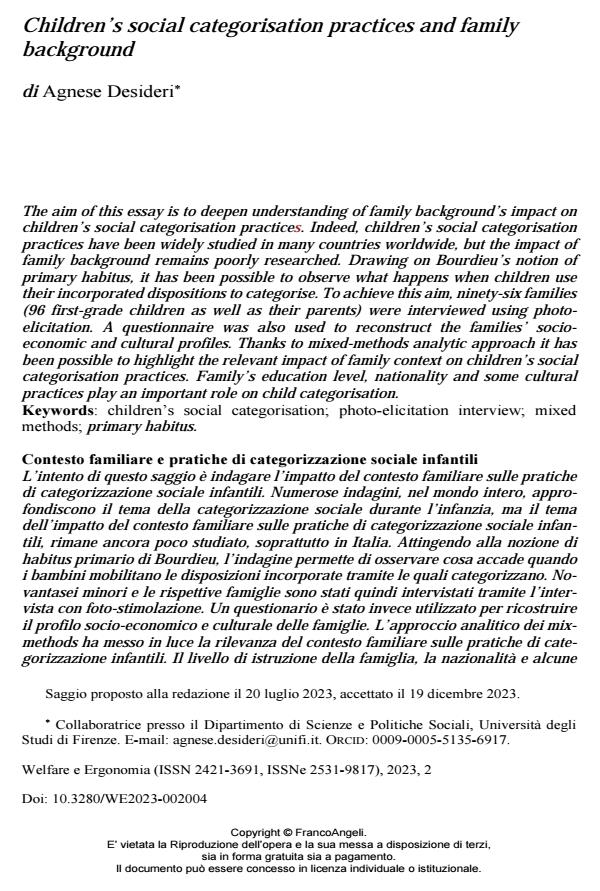Contesto familiare e pratiche di categorizzazione sociale infantili
Journal title WELFARE E ERGONOMIA
Author/s Agnese Desideri
Publishing Year 2024 Issue 2023/2 Language English
Pages 14 P. 43-56 File size 219 KB
DOI 10.3280/WE2023-002004
DOI is like a bar code for intellectual property: to have more infomation
click here
Below, you can see the article first page
If you want to buy this article in PDF format, you can do it, following the instructions to buy download credits

FrancoAngeli is member of Publishers International Linking Association, Inc (PILA), a not-for-profit association which run the CrossRef service enabling links to and from online scholarly content.
The aim of this essay is to deepen understanding of family background’s impact on children’s social categorisation practices. Indeed, children’s social categorisation practices have been widely studied in many countries worldwide, but the impact of family background remains poorly researched. Drawing on Bourdieu’s notion of primary habitus, it has been possible to observe what happens when children use their incorporated dispositions to categorise. To achieve this aim, ninety-six families (96 first-grade children as well as their parents) were interviewed using photo-elicitation. A questionnaire was also used to reconstruct the families’ socio-economic and cultural profiles. Thanks to mixed-methods analytic approach it has been possible to highlight the relevant impact of family context on children’s social categorisation practices. Family’s education level, nationality and some cultural practices play an important role on child categorisation.
Keywords: children’s social categorisation; photo-elicitation interview; mixed methods; primary habitus.
- Abbatecola E. and Stagi L. (2017). Pink Is the New Black: Stereotipi di Genere nella Scuola dell’infanzia. Torino: Rosenberg and Sellier.
- Alanen L. and Siisiäinen M. (2011). Fields and capitals: constructing local life. University of Jyväskylä Finnish Institute for Educational Research.
- Banton M. (2011). A Theory of Social Categories. Sociology, 452: 187-201. DOI: 10.1177/0038038510394013
- Barigozzi F., Cremer H. and Monfardini C. (2019). The Gender Gap in Informal Child Care: Theory and Some Evidence from Italy (June 2019). CEPR Discussion Paper No. DP13782, -- Available at SSRN: https://ssrn.com/abstract=3401869.
- Bhana D. (2016). Gender and childhood sex in primary school. Singapore: Springer.
- Bourdieu P. (1998). Meditazioni pascaliane. Feltrinelli.
- Bourdieu P. (1980). Le Sens Pratique. Paris: Éditions de Minuit.
- Connolly P., Kelly B., and Smith, A. (2009). Ethnic habitus and young children: A case study of Northern Ireland. European Early Childhood Education Research Journal, 17: 217-232. DOI: 10.1080/13502930902951460
- Corbetta P., Gasperoni G., and Pisati M. (2001). Statistica per la ricerca sociale. Bologna: il Mulino.
- Crossley N. (2005). Mapping reflexive body techniques: On body modification and maintenance. Body and Society, 11(1): 1-35. DOI: 10.1177/1357034X05049848
- Desideri A. (2023). L’adozione dell’intervista con foto-stimolazione con minori: accorgimenti e stratagemmi. Sociologia e Ricerca Sociale, 130: 89-107.
- Einarsdóttir J. (2007). Research with children: Methodological and ethical challenges. European. Early, Childhood Education Research Journal, 15(2): 197-211. DOI: 10.1080/13502930701321477
- Gärdenfors P. (2018). An Epigenetic Approach to Semantic Categories. Transactions on Cognitive and Developmental Systems, 12(2): 139-147.
- Garnier P. (2021). Children’s bodies and material culture: a study of children’s physical activities based on games. Childhood, 216-230. DOI: 10.1177/0907568220980513
- Hakovirta M. and Kallio J. (2016). Children’s Perceptions of Poverty. Child Ind Res, 9: 317-334.
- Harper D. (2002). Talking about pictures: A case for photo elicitation. Visual Studies, 17(1): 13-26. DOI: 10.1080/14725860220137345
- Inagaki K. and Hatano G. (2006). Young Children’s Conception of the Biological World. Current Directions in Psychological Science, 15(4): 177-181.
- Kustatscher M. (2017). Young children’s social class identities in everyday life at primary school: The importance of naming and challenging complex inequalities. Childhood, 24(3): 381-395. DOI: 10.1177/0907568216684540
- Lignier W. and Pagis J. (2017). L’enfance de l’ordre: Comment les enfants perçoivent le monde social. Paris: Seuil.
- Lignier W., Lomba C., and Renahy N. (2012). La différenciation sociale des enfants. Politix, 99: 9-21.
- MacGregor C.A. (2008). Religious socialization and children’s prayer as cultural object: Boundary work in children’s 19th century Sunday schoolbooks. Poetics, 36(5): 435-449.
- Mallon R. (2016). The construction of human kinds. Oxford University Press.
- Marrone G. (2001). Corpi sociali: Processi comunicativi e semiotica del testo. Torino: Einaudi.
- Qvortrup J. (2009). Childhood as a Structural Form. In: Qvortrup J., Corsaro W.A., Honig MS., editors, The Palgrave Handbook of Childhood Studies. London: Palgrave Macmillan.
- Shutts K., Brey E.L., Dornbusch L.A., Slywotzky N. and Olson K.R. (2016). Children Use Wealth Cues to Evaluate Others. PLoS ONE, 11(3), e0149360.
- Van der Straten S.W. and Roskam I. (2012). Developmental and Social Determinants of Religious Social Categorisation. The Journal of Genetic Psychology, 173(2): 208-220. DOI: 10.1080/00221325.2011.600356
- Wacquant L. (2014). Mettere l’habitus al suo posto. Etnografia e ricerca qualitativa, 2: 329-48. DOI: 10.3240/77334
- Weinger S. (2000). Economic status: Middle class and poor children's views. Children & Society, 14(2): 135-146.
- Zarca B. (1999). Le sens social des enfants. Sociétés contemporaines, 36:67-101.
- Zerubavel E. (1999). Social mindscapes: An invitation to cognitive sociology. (2ed.). Cambridge: Harvard University Press.
Agnese Desideri, Children’s social categorisation practices and family background in "WELFARE E ERGONOMIA" 2/2023, pp 43-56, DOI: 10.3280/WE2023-002004